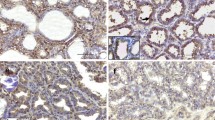Abstract
Fibroblast growth factor-2 (FGF-2) induces gastrulation of rabbit blastocysts in vitro and is present in the uterine secretion at day 6 after mating. The following study was made in order to show if changes in the uterine FGF-2 concentration or in the FGF receptor concentration of the embryonic tissues point to a regulation of this event. By the use of the ELISA technique and immunohistochemistry, FGF-2 concentration was determined in the endometrical tissue, uterine secretion and blastocyst between day 4 and day 8 of pregnancy, in the uterine secretion after induction of pseudopregnancy, in day 6 blastocysts after in vitro culture, and FGF immunoreactivity was localized in the endometrial tissue. FGF receptor-1 (FGFR-1) concentration was examined correspondingly in the blastocyst. Cross-linking experiments using 125I-FGF-2 were done to identify binding proteins in the blastocyst. In the uterine secretion, FGF-2 was constantly high up to day 6.5 but showed an increase thereafter. Similar values in pseudopregnant uterine secretions indicated that the growth factor was of uterine origin. It was probably synthesized by the uterine epithelium as shown by immunohistochemistry. Under culturing conditions, the blastocyst produced small amounts of FGF-2. In the blastocyst, FGFR-1 as well as binding of 125I-FGF-2 showed a dramatic increase from day 6.0 to day 6.5, coinciding with the onset of gastrulation. Receptor antigenicity was located in the embryonic disc at day 6.5 and day 7.0. Two binding proteins of about 200 and 130 kDa were found by cross-linking. The results indicate that a regulation of growth factor influence on embryonic differentiation is more probable via expression of the embryonic receptor than via differential release of the uterine growth factor.
Similar content being viewed by others
References
Abraham JA, Mergia A, Whang JL, Tumolo A, Friedman J, Hjerrild KA, Gospodarowicz D, Fiddes JC (1986) Nucleotide sequence of a bovine clone encoding the angiogenic protein, basic fibroblast growth factor. Science 233:545–548
Finch PW, Rubin JS, Miki T, Ron D, Aaronson SA (1989) Human KGF is FGF-related with properties of a paracrine effector of epithelial cell growth. Science 245:752–755
Florkiewicz RZ, Barid A, Gonzales AM (1991a) Multiple forms of FGF-2: differential nuclear and cell surface localizations. Growth Factors 4:265–275
Florkiewicz RZ, Shibata F, Barankiewicz T, Baird A, Gonzales AM, Florkiewicz E, Shah N (1991b) Basic fibroblast growth factor gene expressions. Ann NY Acad Sci USA 638:109–126
Florkiewicz RZ, Majack RA, Buechler RD, Florkiewicz E (1995) Quantitative export of FGF-2 occurs through an alternative, energy-dependent, non-ER/Golgi pathway. J Cell Physiol 162:388–399
Gospodarowicz D (1990) Fibroblast growth factor and its involvement in developmental processes. Curr Top Dev Biol 24:57–93
Gospodarowicz D, Neufeld G, Schweigerer L (1986) Fibroblast growth factor. Mol Cell Endocrinol 46:187–204
Hrabé de Angelis M, Kirchner C (1993) Fibroblast growth factor induces primitive streak formation in rabbit pre-implantation embryos in vitro. Anat Embryol 187:269–273
Hrabé de Angelis M, Gründker C, Herrmann BG, Kispert A, Kirchner C (1995) Promotion of gastrulation by maternal growth factor in cultured rabbit blastocysts. Cell Tissue Res 282:147–154
Isaacs HV, Tannahill D, Slack JMW (1992) Expression of a novel FGF in the Xenopus embryo: a new candidate inducing factor for mesoderm formation and anterioposterior specification. Development 114:711–720
Jaye M, Schlessinger J, Dionne CA (1992) Fibroblast growth factor receptor tyrosine kinases — molecular analysis and signal transduction. Biochim Biophys Acta 1135:185–199
Jessel TM, Melton DA (1992) Diffusible factors in vertebrate embryonic induction. Cell 68:257–270
Johnson DE, Lee PL, Lu J, Williams LT (1990) Diverse forms of a receptor for acidic and basic fibroblast growth factors. Mol Cell Biol 10:4728–4736
Kraemer R, Pomerantz KB, Joseph-Silverstein J, Hajjar DP (1993) Induction of fibroblast growth factor mRNA and protein synthesis in smooth muscle cells by cholesteryl ester enrichment and 25-hydroxycholesterol. J Biol Chem 268:8040–8045
Lin TH, Mukku VR, Verner G, Kirkland JL, Stancel GM (1988) Autoradiographic localization of epidermal growth factor receptors to all major uterine cell types. Biol Reprod 38:403–411
Mignatti P, Morimoto T, Rifkin DB (1991) Basic fibroblast growth factor released by single, isolated cells stimulates their migration in an autocrine manner. Proc Natl Acas Sci USA 88:1007–1011
Mignatti P, Morimoto T, Rifkin DB (1992) Basic fibroblast growth factor, a protein devoid of secretory signal sequence, is released by cells via a pathway indpendent of the endoplasmic reticulum. J Cell Physiol 151:81–93
Olwin BB, Hauschka SD (1990) Fibroblast growth factor receptor levels decrease during chick embryogenesis. J Cell Biol 110:503–509
Paria BC, Das SK, Andrews GK, Dey SK (1993) Expression of the epidermal growth factor receptor gene is regulated in mouse blastocysts during delayed implantation. Proc Natl Acad Sci USA 90:55–59
Partanen J, Vainikka S, Alitalo K (1993) Structural and functional specificity of FGF receptors. Philos Trans R Soc Lond Biol 340:297–303
Renko M, Quarto N, Morimoto T, Rifkin DB (1990) Nuclear and cytoplasmic localization of different basic fibroblast growth factor species. J Cell Physiol 144:108–114
Rifkin DB, Moscatelli D (1989) Recent developments in the cell biology of basic fibroblast growth factor. J Cell Biol 109:1–6
Slack JMW, Darlington BG, Heath JK, Godsave SF (1987) Mesoderm induction in early Xenopus embryos by heparin-binding growth factors. Nature 326:197–200
Smith JC (1993) Mesoderm-inducing factors in early vertebrate development. EMBO J 12:4463–4470
Unsicker K, Grothe C, Westermann R, Wewetzer K (1992) Cytokines in neural regeneration. Curr Opin Neurobiol 2:671–678
Vainikka S, Joukov V, Wennstrom S, Bergmann M, Pellici PG, Alitalo K (1994) Signal transduction by fibroblast growth factor receptor-4 (FGFR-4) — comparison with FGFR-1. J Biol Chem 269:18320–18326
Viebahn C, Mayer B, Hrabé de Angelis M (1995) Signs of the priciple body axes prior to primitive streak formation in the rabbit embryo. Anat Embryol 192:159–169
Zhan X, Bates B, Hu X, Goldbarb M (1988) The human FGF-5 oncogene encodes a novel protein related to fibroblast growth factors. Mol Cell Biol 8:3487–3497
Author information
Authors and Affiliations
Rights and permissions
About this article
Cite this article
Gründker, C., Kirchner, C. Uterine fibroblast growth factor-2 and embryonic fibroblast growth factor receptor-1 at the beginning of gastrulation in the rabbit. Anat Embryol 194, 169–175 (1996). https://doi.org/10.1007/BF00195010
Accepted:
Issue Date:
DOI: https://doi.org/10.1007/BF00195010




